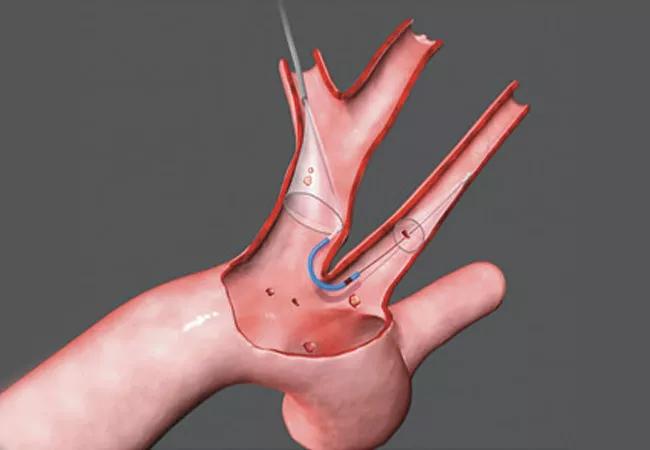Safety considerations prevail in FDA decision on Sentinel device

For the first time, U.S. patients undergoing transcatheter aortic valve replacement (TAVR) are eligible for protection from periprocedural stroke through use of a cerebral protection device. That’s the upshot of the FDA’s June 1 clearance of the Sentinel® Cerebral Protection System for use as embolic protection in patients undergoing TAVR.
Cleveland Clinic is a non-profit academic medical center. Advertising on our site helps support our mission. We do not endorse non-Cleveland Clinic products or services. Policy
Sentinel’s manufacturer announced it is immediately launching the device for use by selected high-volume TAVR centers of excellence around the nation, including Cleveland Clinic.
Approval of the device was based largely on the pivotal SENTINEL trial, which was reported at TCT 2016 and published in Journal of the American College of Cardiology early this year. “This is the first approved device that allows us to capture debris released at time of valve implantation and prevent it from going to the brain,” says the SENTINEL trial’s lead investigator, Samir Kapadia, MD, Section Head of Invasive and Interventional Cardiology at Cleveland Clinic. “This will improve the safety of TAVR even further.”
The Sentinel device, commercially available in Europe since 2013, consists of two cap-shaped filters — one proximal and one distal — to capture embolic debris that may be dislodged during the TAVR procedure, shielding cerebral territories supplied by the bilateral carotid arteries and the right vertebral artery (see illustration above). The left vertebral artery, which supplies approximately 2 percent of brain tissue, is left unprotected.
The dual-filter device is delivered via catheter prior to the TAVR procedure through the right radial (preferred) or brachial artery and is withdrawn into the catheter and removed after TAVR is completed.
The SENTINEL trial randomized 363 patients undergoing TAVR at 19 U.S. and European centers as follows:
While debris was captured in 99 percent of patients in the embolic protection arms, rates of major adverse cardiac and cerebrovascular events (MACCE) at 30 days were not statistically different from those in the control group, although they were noninferior to the trial’s prespecified performance goal.
Similarly, analysis of the imaging cohorts showed that new brain lesion volume was numerically reduced but not statistically different between the protection and no-protection arms. However, after adjustment for baseline lesion volume and TAVR valve type, there was a significant decrease in new lesion volume in protected brain territories in the device arm versus the control arm.
Neurocognitive testing at 30 days after TAVR revealed no significant differences between control patients and those receiving embolic protection, but a significant correlation did emerge between lesion volume and neurocognitive decline.
The embolic debris collected in filters in the 99 percent of patients receiving the device included thrombus, calcification, valve tissue, artery wall and foreign material. “There was a striking consistency of retrieved materials in nearly all patients,” notes Dr. Kapadia.
“SENTINEL showed that this dual-filter neuroprotection therapy is safely deployed and effective in capturing particulate embolic debris from patients undergoing TAVR,” Dr. Kapadia says. “Although there was no difference in neurocognition at 30 days relative to control, an important link was observed between cumulative neurocognition scores and new lesion volumes and numbers.”
Similar sentiments were expressed by an FDA advisory panel earlier this year, which struggled with the mixed efficacy results from the SENTINEL trial but still recommended approval of the Sentinel device in view of its low safety risk and the dearth of other brain-sparing therapy options for TAVR patients.
Dr. Kapadia notes that the device is easy to use and compatible with the standard TAVR workflow. “In SENTINEL, total procedure time was increased by only 13 minutes with use of the device, and fluoroscopy time was extended by 3 minutes,” he says.
Sentinel’s manufacturer said it is working with CMS “to develop a pathway to achieve a new technology add-on payment” and has already established an ICD code for reimbursement of the device.
Although the FDA approval did not require a postmarketing study, the company reportedly is exploring a postmarket registry to monitor new patients who receive the device.
Meanwhile, in his role as lead investigator of the SENTINEL trial, Dr. Kapadia says that study identified several priorities for future research of embolism protection devices in TAVR patients:
For a 90-second video in which Dr. Kapadia discusses which TAVR patients are candidates for the Sentinel device, click here. For a five-minute video of Dr. Kapadia discussing the Sentinel approval more broadly, see the “Cerebral Protection in TAVR” video here.
Illustration of Sentinel device courtesy of Claret Medical, Inc.

Further acute testing not needed if ECG and high-sensitivity troponin are negative

Scott Cameron, MD, PhD, also brings wide-ranging research interests to bear

Pioneering U.K. vascular surgeon joins Cleveland Clinic

AHA statement is first comprehensive document on perioperative stroke reduction

Recognition reflects prioritization of long-term patient outcomes

Recommendations help distinguish exercise-induced remodeling from pathology

JACC review highlights factors unique to women, ways to tailor management

Pushing the envelope in ablation of atrial fibrillation, ventricular tachycardia